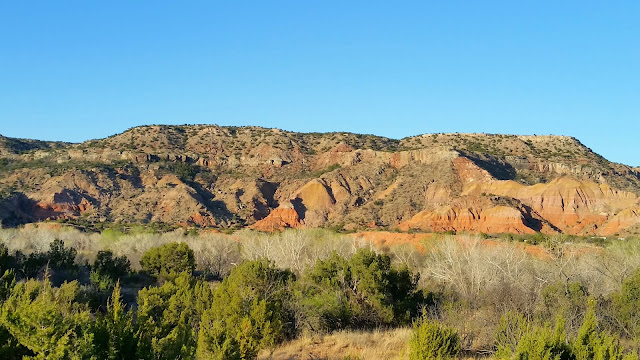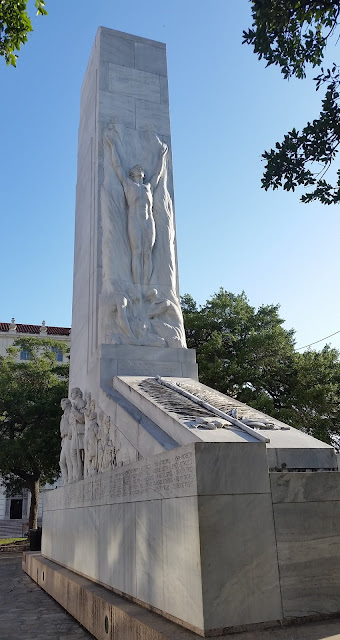Rather than take the Interstate highways, we always opt to take secondary roads. They are more scenic, less congested, and provide a much more relaxing drive. SR 83 and SR 153 met our expectations. Lots of fracking, farming, and fields with cattle, horses and goats grazing. We passed a huge pile of tomatoes on the side of the road, presumably the result of a truck overturning. Talk about one huge serving of pasta sauce (or as my maternal grandparents of Italian descent called it, "gravy")!
After spending the night in Wally World (AKA Wal-mart) in Sweetwater, we got back on the road at 7 a.m., this time taking SR 84, which consisted of acres and acres of wind turbines. Though they stand tall within the fields, it wasn’t until a truck transporting one blade/prop passed us on a roadway that I realized just how Amazonian they really are! Amazing stuff.
We arrived at Palo Duro State Park, home of Palo Duro Canyon, Texas’s version of the Grand Canyon. Though not nearly as deep (only 800 feet vs a mile), as long (only 120 miles vs 273 miles), or as spectacular as the Grand Canyon, Palo Duro Canyon, as the #2 largest canyon in the U.S.A., is quite an impressive sight to see. And while you can only hike or take a mule ride down into the Grand Canyon, you actually drive down into Palo Duro Canyon.
Mom was at the wheel and handled the descending roadway, with its curves, switchbacks, and 10% grade, like a pro!
 |
The step winding road into the Canyon! |
There are several campgrounds within the Park.
Based on the size of our set-up, we were
assigned to Juniper Campground. For
$24/night, we got a huge pull-thru site with water, 50 amp electric, and
covered picnic table. Though no sewer
connection on site, the Park has three dump stations.


In
addition to the campground fee, you must pay an entrance fee of
$5/person/night, which amounted to $30 for our 3-night stay (no charge for
stuffed rats, cats, or goldfish). We
realized as we departed that we could have purchased an annual State Park Pass
for $70, which gives unlimited access to ALL
90 of Texas’s State Parks for a year from the time of purchase. Since Lake Livingston State Park is right
near home base, we would definitely get use out of the annual pass. We ran back
in, and the Park graciously applied our $30 entrance fee toward payment of the
annual pass. But the deal got even
better! The annual Texas State Park Pass
comes with camping discounts! Yup, for
four (4) multi-night camping trips per year, you save 50% off of the second
night, which for us put another $12 into my cheese bank.
In addition to RV sites and tent sites, Palo Duro State Park also has cabins, one built right into the Canyon walls just like a cowboy dugout.
 |
A Cowboy Dugout Cabin |
We
arrived at our campsite and were greeted by a welcoming committee consisting of
two roadrunners! I chuckled at the
irony. You see, despite spending four
winters in Arizona, where the roadrunner is the state bird, we have rarely seen
them. They eluded us as if we were Wyle
E. Coyote. We come to Texas and see not
one, but two, and they came to our camping area every day of our stay.
 |
BEEP BEEP! One of the two roadrunners who visited us daily. |
Once
settled in, we immediately headed back up to the Visitor Center to learn more
about the Park. The Red River, which
flows through the Canyon, was the site of a pivotal battle in the Texas-Indian
Wars. Several of the trails, bridges, and even the Coronado Lodge which houses
this Visitor Center, were all built by the Civilian Conservation Corps (CCC). We hiked the CCC Trail to sample some of
their handiwork.
We
learned that Palo Duro State Park is home to hundreds of geocaches! We found about a dozen of them as we
hiked. Unfortunately, we could not
always log them since we had limited cell/internet service in the Canyon.
Wildlife was abundant in the Canyon. In addition to the roadrunners, we saw deer, rabbits, tom turkeys and hens. While sitting at a blind bird-watching, we were entertained by black-headed grosbeaks, mountain bluebirds, and a half dozen male cardinals all vying for the attention of two females. Most importantly, we saw some fine specimens of Texas Longhorn steer. Our campsite had a colony of some type of burrowing rodents (reminded me of my buddies, the prairie dogs). It seems the Park and the rodents were battling over turf, and the rodents were winning. We also hiked along the River in hopes of seeing a Texas long-horned lizard, but no such luck.
 |
A few of the six boys who were trying to impress a couple of gals. |
 |
This little rodent and his family are testing the patience of the Park groundskeepers, who keep filling holes in a losing battle. |





Speaking of hiking, Palo Duro has more than a dozen trails, including one dedicated to mountain biking (Givens, Spicer, Lowry Trail) and one reserved just for horseback riding (Equestrian Trail). Over the course of our stay, we completed 7 hiking trails, which featured unique rock formations (one looks like a lighthouse and the hues and patterns of another looks like vibrant-colored Spanish skirts).




 |
This is where a cowboy on a cattle ranch would live! |




 |
The Lighthouse Formation |
 |
The white in this rock formation is gypsum. Yup, the same stuff as White Sands! |

And we explored a big cave when hiking the Juniper Cliffside Trail. This was cool, but I must admit I was disappointed that there were no bats within it.

 |
The view from the cave! |
Also of interest was the grave of Shal-a-ko. According to legend, Palo Duro suffered a horrible drought, scorching all crops, and causing ancestral peoples to leave their homeland. Then Shal-a-ko was born, bringing with him the much-needed rains so the peoples could return to their beloved home of Palo Duro. Hence, Shal-a-ko became known as The Rainmaker. Legend says that The Great Spirit loved Shal-a-ko and his peoples so much, that he bestows Palo Duro with much rain, more than the surrounding areas, so that the peoples green oasis will always thrive. Guess that’s why the area succumbs to flooding on a regular basis.
So I have to tell you how difficult it is to be incognito with Big Boomer. When getting out of the truck at an overlook, a young woman came up to us and asked if we were at White Sands in New Mexico last month. Yes, we were, but how did she know that? She remembered seeing Big Boomer there when she was parked at Alkalai Flats! I concede Big Boomer is a bit unique, especially with Rat Patrol on its roof.
 |
Big Boomer, Rat Patrol, and yours truly at a viewpoint. It's tough being so highly recognizable. |
We thoroughly enjoyed Palo Duro State Park. We picked a perfect time to come: mid-week, after Spring break, but before Memorial Day. Hence, it was a peaceful, tranquil visit. Palo Duro State Park is another Texas treasure worthy of a 5-cheese rating!
We would like to thank some amazing organizations for all they do for the RVing community:
Escapees RV Club

Xscapers

RVillage

RV Dreams







































































